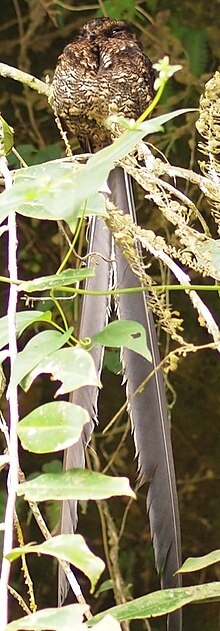Ly-tailed nightjar
| Ly-tailed nightjar | ||||||||||
|---|---|---|---|---|---|---|---|---|---|---|

Lyra-tailed nightjar ( Uropsalis lyra ), adult male in Ecuador |
||||||||||
| Systematics | ||||||||||
|
||||||||||
| Scientific name | ||||||||||
| Uropsalis lyra | ||||||||||
| ( Bonaparte , 1850) |
The lyre-tailed nightjar ( Uropsalis lyra ) is a species of bird from the nightjar family (Caprimulgidae).
It occurs in Argentina , Bolivia , Ecuador , Colombia , Peru and Venezuela .
Their distribution area includes damp cloud or rainforest , clearings , aisles .
description
The lyre-tailed nightjar is 25–28 cm tall, the male weighs about 68, the female between 74 and 79 g. The male has the outer tail feathers, which can be up to 80 cm long. No white on tail or wings, red-brown neck band.
voice
The call of the male is called out from the ground as a series of rising “wéeou-tee” tones or as “wip-wip-wip”.
Geographic variation
The following subspecies are recognized:
- U. l. lyra ( Bonaparte ) , 1850, nominate form - Andes in western Venezuela ( Mérida ), Colombia and Ecuador
- U. l. peruana ( Berlepsch & Stolzmann ) , 1906 - Eastern Andeside from Peru ( Amazon basin ) to Bolivia ( Santa Cruz )
- U. l. argentina Olrog , 1975 - Andes in northern Argentina ( Jujuy ) and possibly southern Bolivia
Way of life
As far as is known, the food consists of insects and moths , which are captured with short leaps from the ground or from a hide. The nightjar is nocturnal and likes to sit on paths.
The breeding season in Colombia is between June and December.
Hazardous situation
The lyre-tailed nightjar is not considered to be endangered ( Least Concern ).
Etymology and history of research
The first description of the lyre-tailed nightjar was made in 1850 by Charles Lucien Bonaparte , under the scientific name Hydropsalis lyra . The type specimen came from Santa Fe de Bogotá. It was Waldron DeWitt Miller who introduced the new genus Uropsalis in 1915 . The word »Uropsalis« is derived from the Greek words »oura σης, ουρα « for »tail« and »psalis, psalidos ψαλις, ψαλιδος « for »scissors«. The species name "lyra" is the Latin word for "lyre". »Peruana« refers to Peru, »argentina« to Argentina.
literature
- James A. Jobling: Helm Dictionary of Scientific Bird Names . Christopher Helm, London 2010, ISBN 978-1-4081-2501-4 .
- Charles Lucien Jules Laurent Bonaparte: Conspectus generum avium . tape 1 . EJ Brill, Leiden 1850 ( biodiversity library ).
- Hans Hermann Carl Ludwig von Berlepsch, Jan Sztolcman: Rapport sur les nouvelles collections ornithologiques faites au Pérou par M. Jean Kalinowski . In: Ornis . tape 13 , no. 2 , 1906, p. 63-133 ( biodiversitylibrary.org ).
- Claës Christian Olrog: Uropsalis lyra nueva para la avifauna Argentinia (Aves: Caprimulgidae) . In: Neotropica . tape 21 , no. 66 , 1975, pp. 147-148 .
- Waldron DeWitt Miller: Three new genera of birds . In: Bulletin of the American Museum of Natural History . tape 34 , no. 17 , 1915, pp. 515-520 ( digitallibrary.amnh.org [PDF; 562 kB ]).
Web links
- Videos, photos and sound recordings of Uropsalis lyra in the Internet Bird Collection
Individual evidence
- ↑ Avibase
- ↑ a b c d Handbook of the Birds of the World
- ↑ a b c d M. McMullan: Field Guide to the Birds of Colombia Rey Naranjo Editores, 2018, ISBN 978-958-8969-77-0
- ↑ IOC World Bird List frogmouths, oilbird, potoos, nightjars
- ^ A b Charles Lucien Jules Laurent Bonaparte p. 59.
- ^ A b Hans Hermann Carl Ludwig von Berlepsch u. a. P. 121.
- ^ A b Claës Christian Olrog p. 148.
- ^ IUCN Redlist
- ^ Waldron DeWitt Miller, p. 516
- ↑ James A. Jobling p. 397
- ↑ James A. Jobling p. 233
Remarks
- ↑ DeWitt Miller assigned the lyre-tailed nightjar to the genus.
